If, like us, you’re the kind of spice fan who likes to sprinkle tabasco over your habanera peppers, then you’ve found your dream dish in Bhutan’s ema datshi.
Basically a curry made from chili peppers and farmer’s cheese, ema datshi can be tweaked for more sensitive palates by switching out the chilis for milder pepper varieties, or even potatoes or mushrooms.
CHILIS, CHILIS EVERYWHERE
In the mountainous kingdom of Bhutan, chilis are treated as vegetables (even though they’re technically fruit) rather than spices and are eaten whole, or used as the principal ingredient in a dish, as in the case of ema datshi. So loved are chilis in Bhutan, they can be given as gifts, offered as compensation when damage has been done by family pets, and even used as currency to reward a job well done.
Indigenous to distant South American lands, chilis didn’t reach the Himalayas until after the Spanish Conquest, when they were first brought back to Spain, and then exported all over the middle east and Asia, mainly through Portuguese traders. They caught on fast and formed the basis of local cuisines from India through Bhutan to the kitchens of Thailand and Vietnam.
EMA DATSHI FROM THE CRADLE
Bhutanese cooking is not for the faint-hearted. Chilis feature strongly, and in the instance of ema datshi, they actually take center stage. Bhutanese kids are given chilis in increasing increments from an early age in order to steel them for a lifetime of chili consumption, and the fruits are even thought by some to have the power to ward off evil spirits.
Given their popularity and their dominant place in the mainstream of the Bhutanese diet, you can only imagine the panic that ensued last year when the country suddenly underwent a shortage of the spicy capsicums.
HAPPINESS IS AN ORGANIC CHILI
Ironically, the great Bhutanese chili shortage of 2016 came about as an indirect effect of the country’s Gross National Happiness policy. One of the central tenets of the government’s strategy for keeping the populace contented is protection of the environment and a sustainable social policy, which logically stretches to the assumption that all beings should be as healthy as possible.
As such, in 2006, the government announced that Bhutan would be the first country in the world to work towards having a 100% organic farming industry by 2020. For various economic reasons, it seems unlikely that this will actually come into fruition within the next two years, but it shows the commitment of the government in the direction of cleaning up agriculture and Bhutanese diets.
CHILIS IN CRISIS
In a country of only 750,000 people where the majority of the population are subsistence farmers working with the meagre 8% of their total land mass that’s fit for agriculture, being entirely self-sufficient as a country is still a tall order. As such, Bhutan has had to rely on its neighboring countries to provide it with its precious chilis, which they ended up getting mostly from India.
But in 2016, a crisis struck: the chilis that were being imported from India were found to contain unacceptably high levels of pesticide. Bhutanese food officials had to make the excruciating Sophie’s Choice of deciding between contaminated chilis and no chilis at all.
They opted for the latter in the name of clean eating and long-term GNH, and the ramifications were cataclysmic. There was a severe shortage of chilis in Bhutan, and as for the ones that could be found at market stalls, the prices shot up so high – in some cases, twenty times more than usual – that many people couldn’t afford to buy them.
Catastrophe was soon averted, however, when an alternative source of clean chilis was found in Kolkata. Bhutan breathed a sigh of relief: stoves around the country were once again fired up, calls were made for greater agricultural self-sufficiency, and a new winter growing program has been put in place. Since then, the government has been forced to additionally import more pesticidal chilis due to the weight of demand, but the hope is that this won’t be a necessity for too much longer.

ABOUT THE RECIPE
If you wanted to make a true-blue Bhutanese ema datshi, you wouldn’t stray too far from using just chilis and cheese in your stew. However, in Bhutan there are also variations on this dish: one made with mushrooms which is called shamu datshi and another with potatoes called kewa datshi.
We’ve decided to tone down our ema datshi by mixing the chili peppers with regular non-spicy peppers, and by mixing in some oyster mushrooms to usher in a little shamu datshi hybrid.
Bhutanese cooks generally use yak’s cheese for this dish, but that’s one type of cheese that’s pretty hard to come by in our part of the world unless you happen to have a yak in your backyard. As an alternative, we’ve gone for a mildly pungent brand of feta and then some cream cheese to bulk up the sauce and make it as creamy as possible.
By the way, if you like cheese, you might like our other recipe on Quesillo Nicaraguan Tortill and Cheese or our other recipe on Curacao Stuffed Cheese Casserole.
CHOOSE YOUR INGREDIENTS
This is really such a straightforward dish to make, and as you can see the ingredients are pretty simple. Take your time sweating the vegetables in the wok over medium heat to get the best flavors out of them without burning them.
You can have fun choosing which peppers you want to work with – we decided on a mixture of red bell peppers (mild), banana peppers (medium) and green chilis (for the kick and for their fragrance). You can tweak the amounts according to how much of your head you’d like to have blown off by your ema datshi.
PREPARING YOUR EMA DATSHI
Get all your ingredients chopped and wok-ready.

Melt a knob of butter into a wok placed over a medium heat.
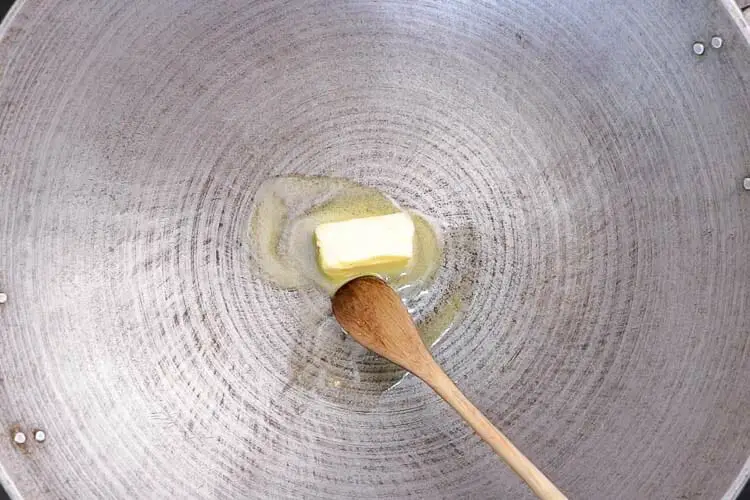
When the butter is heated, throw in the sliced peppers. Sautee until they are aromatic.
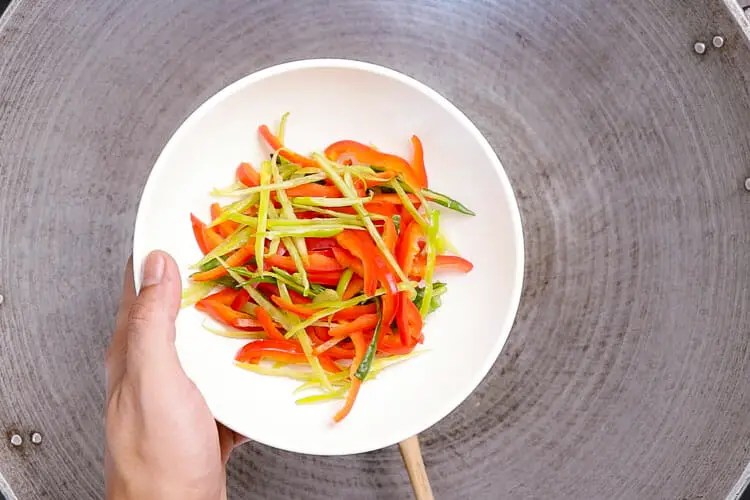
Follow the peppers up with the onions and sweat them until they become translucent. Then add the garlic and keep on the heat until you can smell their aroma. Be careful not to burn the ingredients, especially the garlic.
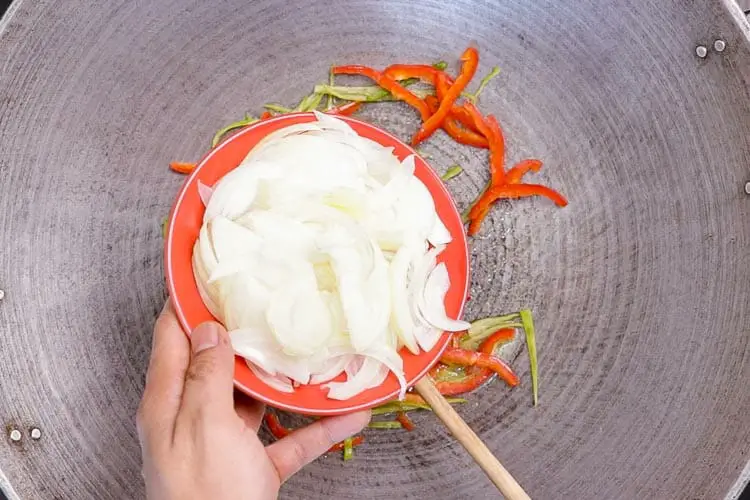
Now add two cups of water and bring to a simmer. Now throw in the chopped tomatoes.

And now you can also add the oyster mushrooms.

The oyster mushrooms are perfect for soaking up the juices from the other vegetables and the broth. Cover the mixture and simmer for five minutes.
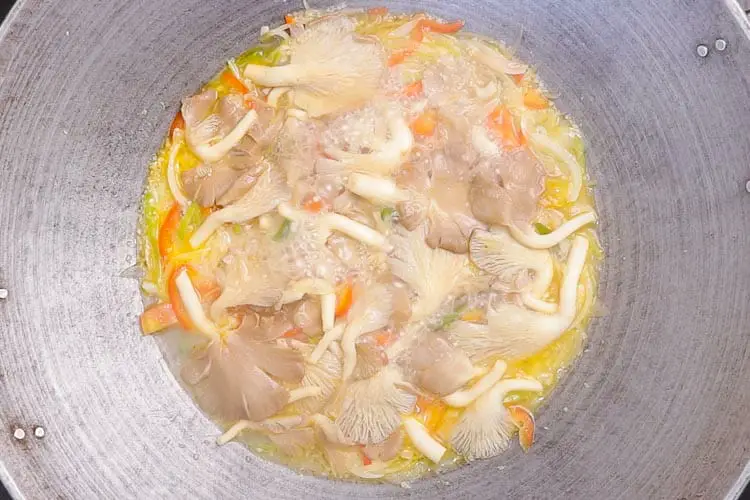
Now add the feta cheese, cut into small cubes, and the cream cheese. Stir in well until the cream cheese is completely dispersed. Keep the wok on a simmer until the sauce is nice and thick and creamy.
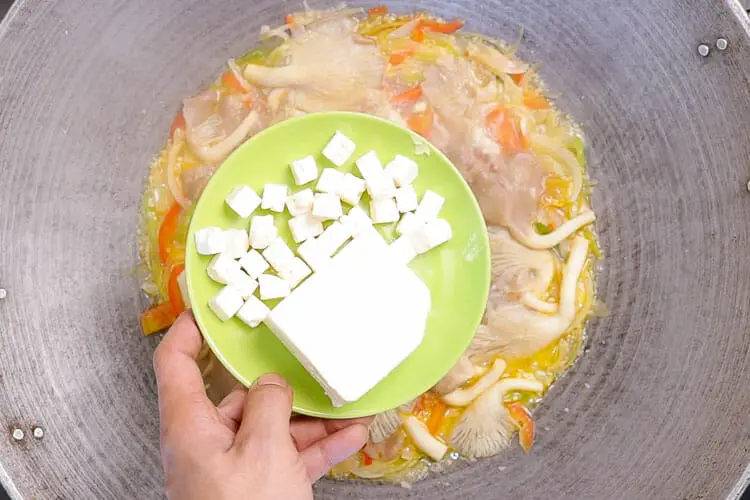
Your ema datshi is done! Garnish with some chopped parsley and serve right away with some rice. In Bhutan, the traditional side would be red rice, and if you can find it, we highly recommend trying it. You can also try a nutrient dense rice cooked with coconut milk and turmeric with a neutral tasting profile, or get a little fancy and eat it with Cantonese fried rice. Of course there’s nothing wrong with plain white rice either!
Tashi delek – good luck!
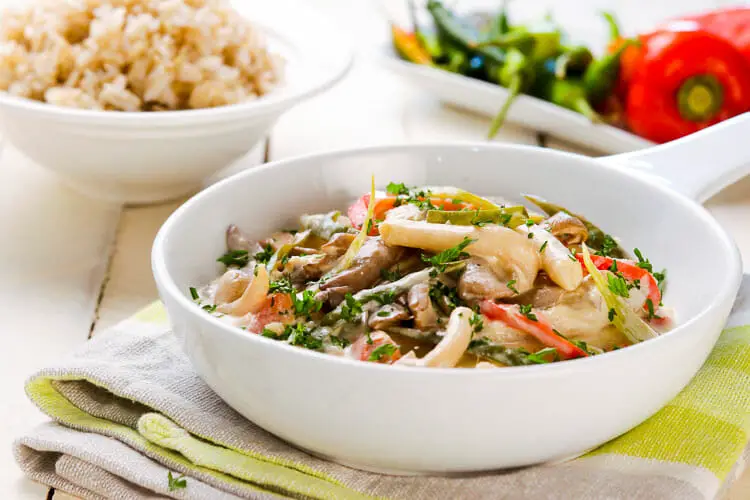
OUR TAKE ON THE RECIPE
We found this version of ema datshi to be perfectly spicy. The mixture of ingredients worked really well to balance out the creaminess and richness of the dish. It was really aromatic too.
As we mentioned before, we decided to build on our source recipe by adding mushrooms and varying the peppers in order to bring down the heat of the dish a little. We love oyster mushrooms for their sponge-like quality in soaking up all the flavors of the sauce, but there are many other different types of mushrooms you could experiment with, like buna shimeji, portobellos, enoki, champignons, etc.
We also enjoyed taking a break from meat and making this vegetarian curry. Having said that, when we make it again, we might consider adding some meat. In Bhutan, the diet is largely vegetarian, but we did find this Tibetan variation on ema datshi that made us think the dish could taste good with some juicy chunks of beef. This recipe also called for blue cheese, which we think would add a kick more similar to the original Bhutanese yak cheese.
On a second cooking, we might also try starting off the sauce with a stronger tomato base, to give the stew a bit more body.
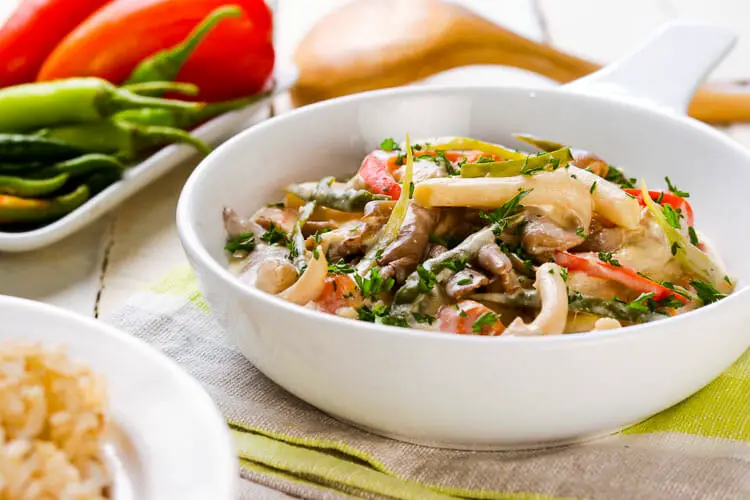


Ema Datshi – Cheese Stew with Feta
- Total Time: 25 minutes
Ingredients
Ema Datshi:
- 2 tbsp unsalted butter
- 3.5 oz red bell peppers, sliced thinly
- 1 oz banana peppers, sliced thinly
- ¼ oz green chilis, sliced thinly
- 1 onion, sliced
- 5 cloves garlic
- 2 cups water or stock
- 2 tomatoes, chopped
- 3 oz oyster mushrooms
- 2 oz feta cheese, cut into cubes
- 7 oz cream cheese
- Parsley to garnish
Instructions
Step 1: Saute Peppers, Onions and Garlic
- Melt butter in a wok.
- Add the peppers (bell, banana, and green chili) and sauté until aromatic.
- Add the onions and sweat until translucent.
- Add the garlic and sauté until aromatic. Do not allow to burn.
Step 2: Add Stock, Tomatoes and Mushrooms
- Add the water or stock and bring to a simmer.
- Add the chopped tomatoes and the oyster mushrooms.
- Cover and simmer for 5 minutes.
Step 3: Add Cheese
- Stir in the feta and cream cheese.
- Simmer over a low heat, stirring constantly until sauce is creamy and slightly thick.
Step 4: Garnish and Serve
- Garnish with chopped parsley.
- Serve with red or wholegrain rice
Notes
- Prep Time: 10 min
- Cook Time: 15 min

Looks nice. I want to try this recipe. Also, I hope to travel to Bhutan one day.